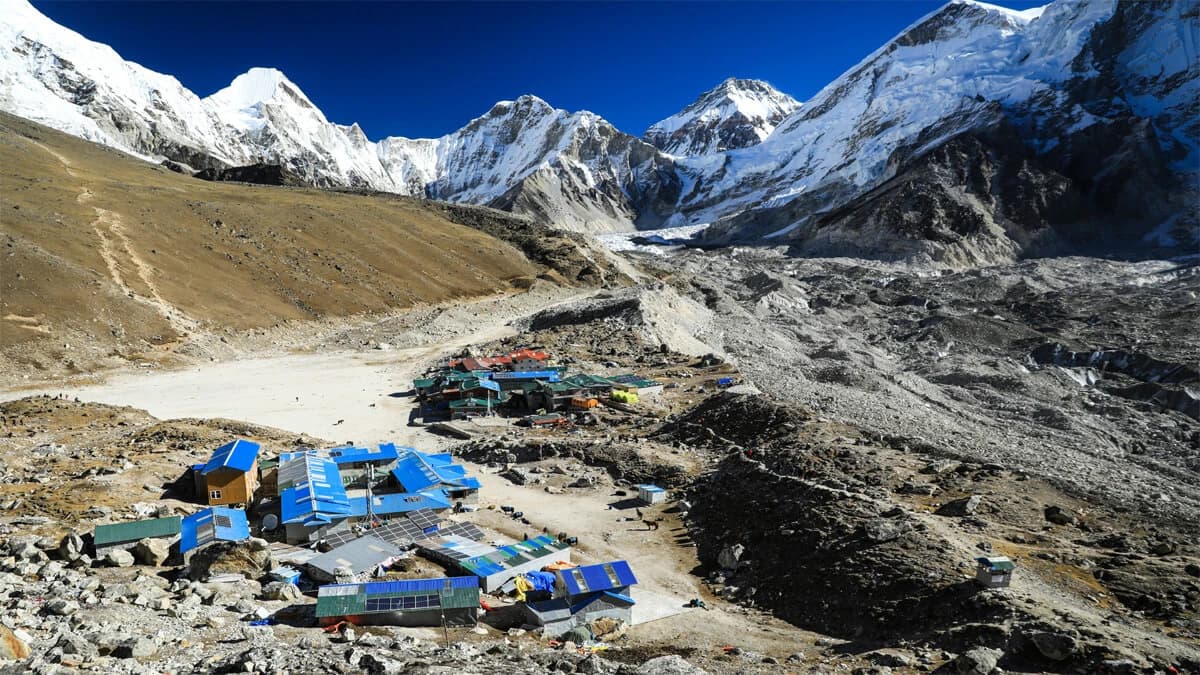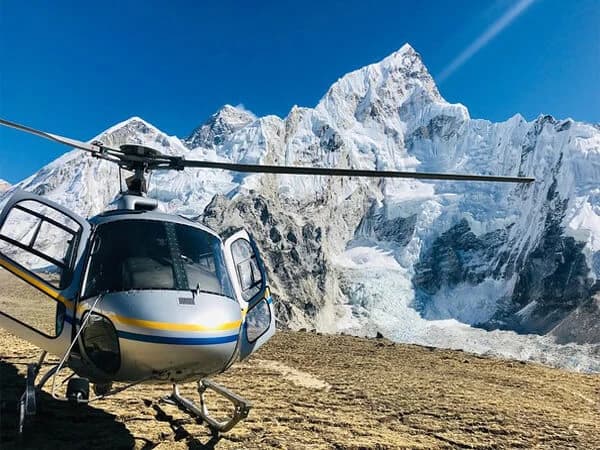Dreaming of an adventure that will take you through the world's tallest mountains, challenge your endurance, and reward you with breathtaking vistas? If trekking to Everest Base Camp (EBC) has always been on your bucket list, then you’ve made a fantastic choice. But wait! What if we told you there’s an even better way to experience it? Picture this: after an incredible, exhilarating trek to the iconic Everest Base Camp, you hop into a helicopter and soar over the very terrain you’ve conquered, enjoying spectacular aerial views before being whisked back to Kathmandu in comfort.
Sounds amazing? That’s because it is! This ultimate guide will take you through everything you need to know about the Everest Base Camp trek with a helicopter return, from the best seasons to go, what to pack, how to prepare, and all the thrilling details of the journey itself. So, lace up your boots, and let’s get trekking!
The Trekking Experience: What to Expect on the Way to Everest Base Camp
The Everest Base Camp trek is one of the world’s most famous treks for a reason. It’s challenging but not impossible, remote yet accessible, and offers some of the most dramatic landscapes you can imagine. Here’s a quick breakdown of what the trek looks like:

- 1. Arrival in Kathmandu: Your journey will begin in Nepal’s buzzing capital, Kathmandu. You’ll have a chance to explore the city’s vibrant streets, try some local cuisine (hello, momos!), and prepare for your adventure. Don’t miss the iconic Durbar Square and Boudhanath Stupa while you’re in town.
- 2. The Flight to Lukla(2,840m): From Kathmandu, you’ll take a short, thrilling flight to Lukla (one of the world's most exciting airports). The views from the plane are spectacular, and you’ll get your first glimpse of the towering Himalayan peaks. Just a heads-up: Lukla is known for unpredictable weather, so be prepared for possible delays.
- 3. Lukla to Phakding(2,610m): Your trek starts gently with a hike from Lukla to Phakding, which takes about 3-4 hours. The trail winds through lush forests, alongside the Dudh Koshi River, and past local Sherpa villages.
- 4. Phakding to Namche Bazaar(3,440m): This is where things get interesting. The next leg takes you to Namche Bazaar, the gateway to Everest and the region's main trading hub. It’s a challenging day, but the panoramic mountain views and the sight of Everest in the distance will keep you going. Namche is where you’ll spend a couple of days acclimatizing.
- 5. Namche to Tengboche(3,860m): The trek continues through dense forests and alpine meadows, passing by Tengboche, known for its stunning monastery and views of Ama Dablam, before continuing to higher altitudes. As you gain elevation, the landscape becomes more rugged, the air thinner, and the views even more jaw-dropping.
- 6. Tengboche to Dingboche(4410m): From Tengboche, you go downhill past the dense forests. As you continue trekking the vegetation changes from trees to shrubs and the landscape turns rocky. You will gain altitude when you reach Dingboche and take a rest overnight. At Dingboche, you will spend a day acclimatizing. You will have plenty of time to observe Sherpa culture and yaks playing in the fields.
- 7. Dingboche to Lobuche: You will trek further from Dingboche to Lobuche through open lands crossed by sparkling streams. You will enjoy spectacular views of Mount Everest, Lhotse, and Thamserku along this trail. You can pay tribute to the memorials erected in the name of trekkers who lost their lives in the Everest region.
- 8. Lobuche to Gorak Shep and Everest Base Camp: After a couple of days of trekking, you’ll arrive at Gorak Shep, your base for the final push to Everest Base Camp. The hike to EBC itself is a surreal experience—standing at 5,364 meters (17,598 feet) with Everest looming above, you’ll feel on top of the world.
- 9. The Helicopter Return: And here’s where the magic happens. Instead of retracing your steps, you’ll hop on a helicopter for an unforgettable flight back to Kathmandu. The aerial views of the Khumbu region, with glaciers, rivers, and those towering peaks, are breathtaking. After days of trekking, you'll get to see the full extent of the journey you've covered from a whole new perspective.
The Best Time to Trek to Everest Base Camp with a Helicopter Return

Timing is key when planning your EBC adventure. The best seasons to trek to Everest Base Camp are Spring (March-May) and Autumn (September-November). These periods offer the most stable weather and clear skies, perfect for trekking and the helicopter ride back. Let’s break it down:
Everest Base Camp Trek with Helicopter Return in Spring Season (March-May)
Spring is all about blooming flowers, fresh mountain air, and longer daylight hours. The rhododendron forests come alive with color, and the skies are generally clear, especially in the mornings. This is also when Everest expeditions begin, so you may even spot climbers going to the summit.
- Advantages: Pleasant temperatures, clear views, beautiful flora, and seeing Everest climbers in action.
- Challenges: It’s a popular time, so expect the trails to be busy with fellow trekkers.
Everest Base Camp Trek with Helicopter Return in Autumn Season (September-November)
After the summer monsoon, the skies clear up, revealing crisp, stunning views of the Himalayas. The weather is perfect for trekking, cool but not freezing, and dry trails make for an easier walk. The post-monsoon period brings excellent visibility for both trekkers and helicopter rides.
- Advantages: Crystal-clear skies, comfortable temperatures, and dry trails.
- Challenges: Like spring, autumn is also peak trekking season, so expect some crowds.
Everest Base Camp Trek with Helicopter Return in Winter Season (December-February)
If you’re a fan of snow and solitude, winter might just be your time to shine. The trails are quiet, and the snow-covered peaks look magical. However, temperatures can plummet, especially at night, and some passes may be snowed in.
- Advantages: Fewer people, snow-capped vistas, and a sense of serenity.
- Challenges: Freezing temperatures, some closed teahouses, and potential trail difficulties due to snow.
Everest Base Camp Trek with Helicopter Return in Summer Season (June-August)
Summer brings the monsoon season, which means rain, clouds, and muddy trails. While it’s not the ideal time for trekking, those brave enough to go during this time will experience lush, green landscapes and far fewer tourists.
- Advantages: Lush greenery, fewer crowds, and a quieter trek.
- Challenges: Rain, slippery trails, and potential flight delays due to weather.
How to Prepare for the Everest Base Camp Trek with Helicopter Return

Trekking to Everest Base Camp is no walk in the park, but with the right preparation, you can make the journey enjoyable and safe. Here’s what you need to know:
Get in Shape
While you don’t need to be a super athlete to complete the trek, a good level of fitness will make the experience far more enjoyable. Focus on building endurance through regular hikes, walking, or running, and consider strength training for your legs and core. And don’t forget to practice with a loaded backpack you’ll be carrying your gear for several hours each day.
Acclimatize Properly
The biggest challenge on the Everest Base Camp trek is the altitude. The trek reaches over 5,000 meters, and altitude sickness is a real concern. It’s essential to take rest days to allow your body to adjust to the thinner air. The most common places to acclimatize are Namche Bazaar and Dingboche.
Signs of altitude sickness: Headache, dizziness, nausea, fatigue. If you experience these, it’s crucial to descend and give your body time to adjust.
Pack Smart
Packing for the EBC trek requires careful planning. You’ll need to be prepared for a range of conditions, from warm days in the sun to freezing nights at higher altitudes. Here’s a quick checklist of essentials:
- Layers, layers, layers: Thermal base layers, fleece mid-layers, and a waterproof jacket are key.
- Good hiking boots: Make sure they’re broken in!
- Sleeping bag: A high-quality, warm sleeping bag rated for sub-zero temperatures.
- Trekking poles: These will save your knees, especially on the downhill sections.
- Sunscreen and sunglasses: The sun at high altitudes is intense.
- Snacks: While tea houses provide meals, having some energy bars or trail mix will keep you fueled on the go.
Permits
You’ll need a couple of permits for the Everest Base Camp trek: the Sagarmatha National Park Entry Permit and the Khumbu Pasang Lhamu Rural Municipality Permit. These can be arranged in Kathmandu or Lukla by your trekking agencyNepal Trekking Routes Pvt. Ltd.
Highlights Along the Route
The journey to Everest Base Camp is filled with unforgettable moments, but here are a few highlights you absolutely won’t want to miss:
Namche Bazaar: This bustling Sherpa town is a trekker’s dream, with cafes, shops, and even Wi-Fi! The views from the Namche viewpoint are worth the extra effort.
- Tengboche Monastery: At 3,867 meters, this spiritual center offers some of the best views of Ama Dablam, Everest, and Lhotse. The monastery itself is peaceful, and if you're lucky, you might witness a Buddhist ceremony.
- Kala Patthar: While Everest Base Camp is the ultimate goal, the hike to Kala Patthar (5,545 meters) offers the best panoramic view of Mount Everest. It's the highest point most trekkers reach, and the sunrise from here is pure magic.
- The Helicopter Ride: The cherry on top of the trek! After days of hard work, the helicopter return is a once-in-a-lifetime experience. You’ll get to see Everest from an entirely new perspective as you soar over glaciers, valleys, and villages.
Health and Safety on the Trail
Your safety is the most important aspect of the trek. Here are a few tips to ensure you stay healthy and safe during your adventure:
- Stay hydrated: Dehydration can make altitude sickness worse, so drink plenty of water.
- Take it slow: Trekking at high altitude is all about pacing. The slower you go, the better chance your body has to acclimatize.
- Watch for altitude sickness: If you experience symptoms like headaches or nausea, let your guide know immediately.
- Pack a basic first aid kit: Include essentials like blister pads, bandages, painkillers, and any personal medications.
Conclusion: Is the Everest Base Camp Trek with Helicopter Return Worth It?
In a word: absolutely! The Everest Base Camp trek is already one of the most iconic adventures in the world, but adding a helicopter return takes it to a whole new level. After days of trekking through challenging, awe-inspiring terrain, you’ll get the reward of flying over the very mountains you’ve been climbing toward. It’s the perfect way to cap off an unforgettable journey, giving you both the satisfaction of reaching Everest Base Camp and the luxury of a stunning, comfortable return.
So, suppose you’re looking for a once-in-a-lifetime adventure that combines physical challenge, cultural immersion, and jaw-dropping natural beauty. In that case, the Everest Base Camp trek with helicopter return is calling your name. Time to answer that call!









